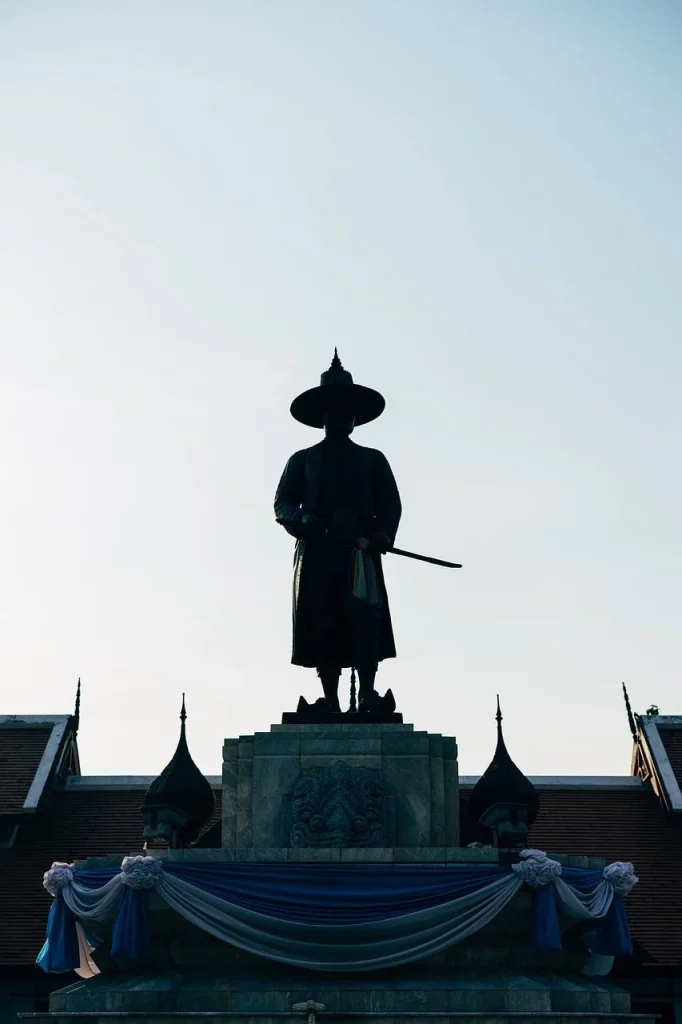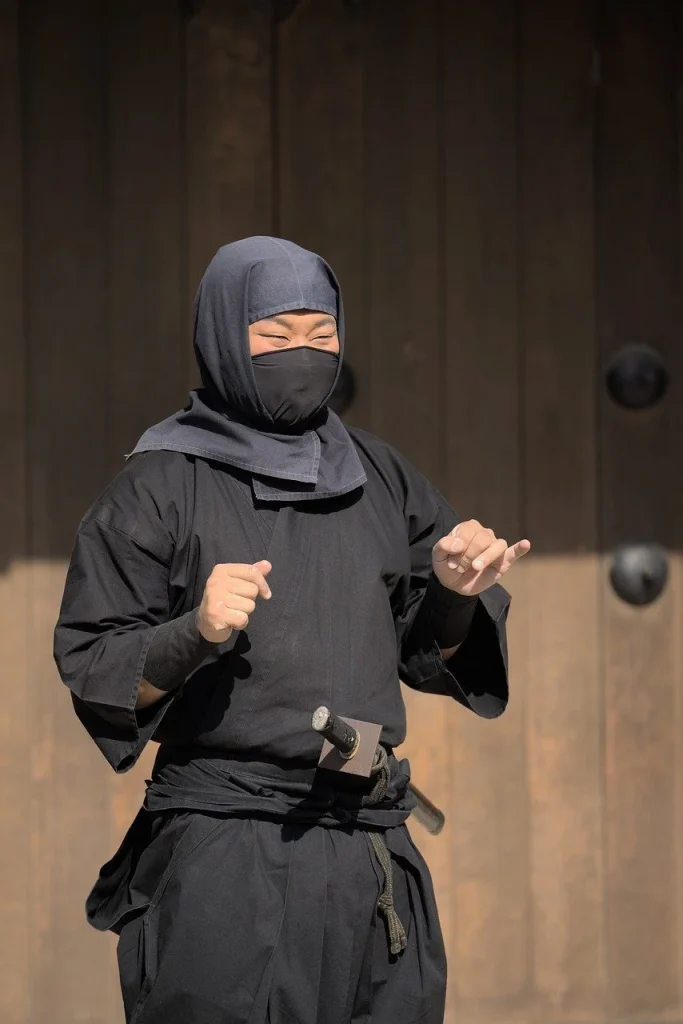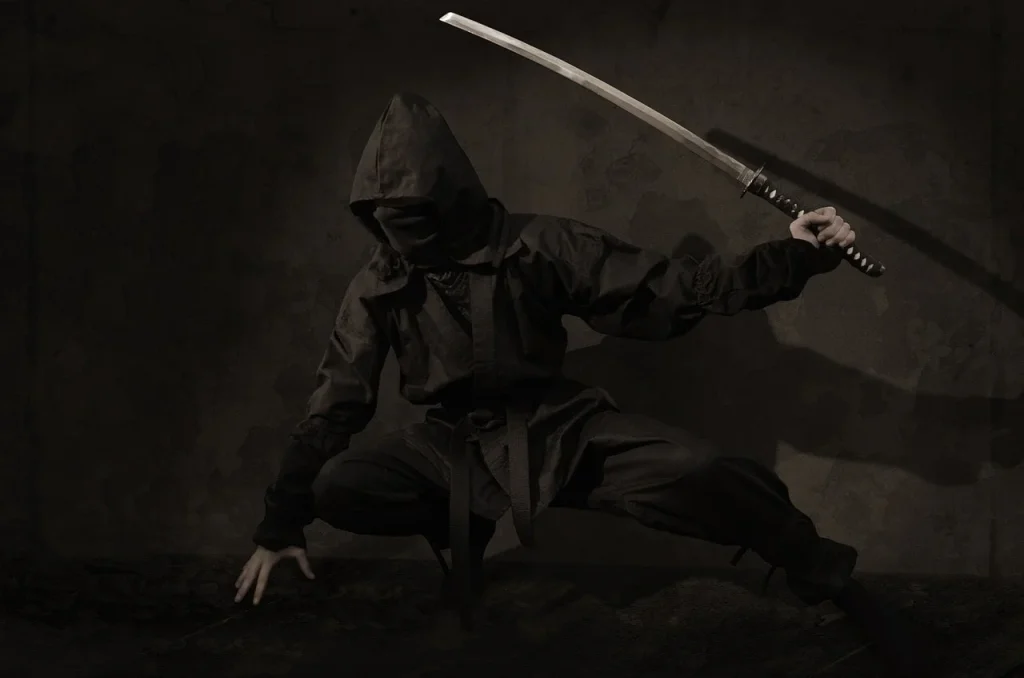Have you ever wondered how ninjas managed to be so mysterious and cool? Well, you’re not alone! Ninjas have been capturing imaginations for centuries with their secretive lifestyles and impressive martial arts skills.
From sneaking around in the shadows to performing incredible feats of agility, these stealthy warriors are the stuff of legends. Today, we’re diving into the world of ninjas with 50 fascinating facts that will blow your mind.
Stick around, and you might just learn how to dodge a shuriken or two! Are you ready to unleash your inner ninja?
The ninja doesn’t sweat the small stuff; he makes the small stuff sweat him.
Stephen K. Hayes
Ninja Facts
As you dive into the shadows of history, remember that there’s a quiz at the end of this article. Read carefully to test your knowledge and prove your expertise on ninjas.
- Their origins trace back to the 14th century during feudal Japan, primarily as a counter to oppressive samurai rule.
- The art they practiced, Ninjutsu, encompassed espionage, guerilla warfare, and assassination techniques.
- Their training began in childhood, focusing on mental and physical disciplines.
- Contrary to popular belief, they often wore dark blue clothing at night for better camouflage.
- Their footwear, tabi boots, were split-toed to help maintain silence and balance.
- Shurikens, or throwing stars, were not just weapons but also served as tools for distraction.
- Female operatives, known as kunoichi, often used their roles as servants or entertainers to spy on rival factions.
- They used a variety of disguises, blending in as monks, merchants, or entertainers, to gather information without raising suspicion.
- The Iga and Koga regions of Japan are famed for being the heartlands of their training grounds.
- They utilized a variety of poisons, both for assassination and for weakening enemies before an attack.
- Secrecy was so integral to their lifestyle that much of their history was passed down orally, not written.
- They were also skilled in the use of medicinal plants to heal injuries and concoct remedies.
- Their diet was specially designed to eliminate body odors to avoid detection during missions.

- Ashiaro are wooden pads attached to their shoes to disguise their footprints as those of children or animals.
- Their espionage skills were so advanced that they sometimes planted agents years in advance in enemy territories.
- Tools of their trade included the kaginawa, a type of grappling hook used for climbing and escaping.
- Legend suggests they used mirrors to send signals across long distances during daylight.
- Water spider shoes allowed them to distribute their weight and walk on swampy or shallow water surfaces.
- Black eggs filled with glass shards and pepper were thrown to create a blinding smokescreen.
- They often used ciphered messages to communicate secret plans and information.
- Breathing tubes made from reeds allowed them to hide underwater for extended periods of time.
- Their survival techniques included knowledge of meteorology to predict weather changes.
- Some practiced the art of Ukemi, which involved falling and rolling to avoid injury from great heights.
- They were also skilled in horsemanship, although popular culture seldom highlights this skill.
- Their swords, known as shinobigatana, were shorter and more curved than those of samurai.
- Family members were often unaware of their roles, believing them to have mundane occupations.
- Historical records of their operations are scarce, as many were conducted in utmost secrecy and not documented.
- They developed and used firearms during the later periods of their activity, particularly hand cannons.

- Anecdotes suggest they used animals, such as birds, to mask the sounds of their movements.
- The tactics they employed were considered dishonorable by samurai, leading to a negative portrayal in some historical texts.
- They were adept at constructing hidden compartments and passages within buildings, known as donohi.
- Mokuton-jutsu was a technique to climb trees and remain unseen for hours, perfect for ambushes.
- Sleep was also mastered, with techniques to remain alert even during rest.
- Deception played a critical role in their strategy, often involving staged scenarios to mislead enemies.
- Training could include walking on rice paper without tearing it to develop light and silent footsteps.
- Their use of psychological warfare, such as spreading rumors to instill fear, was a key tactic.
- Some ninjas were known to practice hensogakure-jutsu, the art of changing one’s appearance and voice.
- Tools like sunekakushi, spiked rings worn on the legs, were used to wound pursuers during chases.

- Training included memorization of important terrain and building layouts for quick escapes.
- Historically, they rarely operated alone, often working in groups to accomplish complex missions.
- Women were especially effective in roles that required infiltrating homes as they could pose as maids or entertainers.
- Smoke bombs and other diversions were common tools to facilitate sudden disappearances or escapes.
- Despite their stealthy nature, many were highly skilled in direct combat, ready to engage if necessary.
- Training involved the ability to understand and use explosive devices, a rare skill in feudal Japan.
- They sometimes served as guards or police forces for their communities, using their skills for protection.
- Some specialized in underwater demolitions and sabotage.
- There is evidence that they engaged in early forms of psychological evaluation to understand and manipulate opponents.
- They often used katon-no-jutsu, a method involving fire and smoke to create chaos and aid in their missions.
- The last recorded use of traditional ninjutsu techniques was observed during World War II in intelligence operations.
- Despite their historical role, modern depictions often exaggerate their abilities to mythical proportions.
Ninja Myths

Now that we’ve explored the facts, let’s dive into the myths. In this section, we’ll separate the legendary tales from the historical truths about ninjas.
- Ninjas Always Wore Black
Contrary to popular belief, they were rarely dressed in black. In reality, clothes of dark blue or other dark hues were often preferred for night operations, but they primarily wore disguises as civilians to blend in. - Ninjas Were Solely Assassins
Although they could be hired as assassins, their roles were diverse. Espionage, scouting, and even serving as bodyguards were tasks commonly undertaken by them, showing their versatility beyond mere killing. - Ninjas Used Exotic and Mystical Weapons
It is widely assumed that they used strange weapons, but standard tools like swords, spears, and bows were typically utilized. Adaptations were sometimes made to these tools to suit covert operations. - Ninjas Possessed Supernatural Powers
The belief that they had magical abilities is exaggerated. Skills like stealth, the use of disguises, and escape techniques were developed to such a high degree that they seemed supernatural to an uninformed observer. - Ninjas Operated Alone
Often depicted as lone warriors, they usually worked in groups. Cooperation was emphasized within their ranks to successfully accomplish complex missions and strategies.
No products found.
Ninja Quotes

Let’s continue our journey. This section gathers quotes that illuminate the lives and philosophies of these enigmatic warriors, offering a glimpse into their shrouded world.
In the world of the ninja, patience is not a virtue, it is a weapon.
Masaaki Hatsumi
Masaaki Hatsumi, a grandmaster of the martial art of Bujinkan, highlights the strategic importance of patience in the ninja’s arsenal.
Ninjas don’t wish upon a star, they throw them.
Jarius Raphel
Jarius Raphel, known for his writings on martial arts, creatively refers to the shuriken, or throwing star, a well-known weapon of the ninja.
The successful warrior is the average man, with laser-like focus.
Bruce Lee
Bruce Lee, a legendary martial artist and actor, underscores the power of focus, a trait highly valuable to ninjas.
Be like a ninja, silent but always ready.
Anonymous
An anonymous saying that encapsulates the ninja’s essence of stealth and preparedness.
The ninja survives in ways that seem magical to others.
Stephen K. Hayes
Stephen K. Hayes again, this time elucidating the almost mystical methods and survival techniques employed by ninjas that astonish the uninitiated.
Ninja FAQ

As we move away from quotes, prepare for the FAQ section. Read carefully, as this will prepare you for the quiz that follows.
- Are ninjas Chinese or Japanese?
They are historically Japanese. They were skilled operatives during the feudal period in Japan, primarily known for espionage, sabotage, and assassination. - Can ninjas eat meat?
Yes, they can eat meat. Their diet was practical, focusing on nutrition that would support their physically demanding lifestyle, which often included meat. - Are ninja stars illegal?
In many places, yes, ninja stars (shuriken) are illegal. Laws vary by country and even by state or region within countries, often categorizing them as concealed weapons. - How were ninjas trained?
Ninjas underwent rigorous training in a variety of martial arts styles and tactics, including stealth movements, the use of poisons, and disguise. Training could begin in childhood and was often conducted within family clans. - Are there still ninjas today?
While their traditional role has faded, their practices and martial arts techniques have been preserved in some schools and passed down through generations, primarily as a cultural or athletic activity.
No products found.
Ninja Quiz

Welcome to the Ultimate Ninja Quiz! Sharpen your shuriken and focus your chi, because if you don’t answer correctly, you might just find your shoelaces mysteriously tied together!
Ninja Merch
If you are a true ninja fan, then you definitely need to check out our merchandise. You can find T-shirts, hoodies, mugs, and tote bags for your favorite designs. Feel free to check out all the other designs in our shop.
Conclusion
Exploring the world of ninjas has taken us into the shadows of history, where strategy, skill, and surprise ruled the day. Ninjas, with their stealth techniques and tools, were more than just warriors; they were the ultimate masters of disguise and intelligence gathering.
Their legacy continues to influence modern culture and martial arts, keeping the ninja spirit alive. As we conclude our ninja journey, it’s fun to consider: If a ninja fought in a forest and nobody was around to see it, did the battle really happen? Let me know in the comments.


